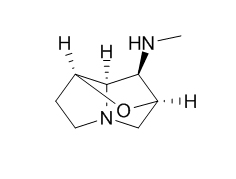Loline
Loline can reduce prolactin release at the highest concentration, 10(-4) M.
Inquire / Order:
manager@chemfaces.com
Technical Inquiries:
service@chemfaces.com
Tel:
+86-27-84237783
Fax:
+86-27-84254680
Address:
1 Building, No. 83, CheCheng Rd., Wuhan Economic and Technological Development Zone, Wuhan, Hubei 430056, PRC
Providing storage is as stated on the product vial and the vial is kept tightly sealed, the product can be stored for up to
24 months(2-8C).
Wherever possible, you should prepare and use solutions on the same day. However, if you need to make up stock solutions in advance, we recommend that you store the solution as aliquots in tightly sealed vials at -20C. Generally, these will be useable for up to two weeks. Before use, and prior to opening the vial we recommend that you allow your product to equilibrate to room temperature for at least 1 hour.
Need more advice on solubility, usage and handling? Please email to: service@chemfaces.com
The packaging of the product may have turned upside down during transportation, resulting in the natural compounds adhering to the neck or cap of the vial. take the vial out of its packaging and gently shake to let the compounds fall to the bottom of the vial. for liquid products, centrifuge at 200-500 RPM to gather the liquid at the bottom of the vial. try to avoid loss or contamination during handling.
Pharmacia2024, 71:1-9.
bioRxiv2021, 458409.
The Journal of Supercritical Fluids2021, 176:105305.
J Sci Food Agric.2023, 103(1):213-220.
Molecules.2023, 28(3):958.
Int J Mol Sci.2022, 23(1):538.
J Cell Mol Med.2024, 28(16):e70016.
Food Analytical Methods2017, 10:3225-3234
Chem Biodivers.2023, 20(12):e202301461.
Institute of Food Science & Technology2021, 18 December.
Related and Featured Products
ISME J. 2014 Feb;8(2):359-68.
Loline alkaloid production by fungal endophytes of Fescue species select for particular epiphytic bacterial microflora.[Pubmed:
24108329]
The leaves of fescue grasses are protected from herbivores by the production of Loline alkaloids by the mutualist fungal endophytes Neotyphodium sp. or Epichloë sp.
METHODS AND RESULTS:
Most bacteria that reside on the leaf surface of such grasses can consume these defensive chemicals. Loline-consuming bacteria are rare on the leaves of other plant species. Several bacterial species including Burkholderia ambifaria recovered from tall fescue could use N-formyl Loline as a sole carbon and nitrogen source in culture and achieved population sizes that were about eightfold higher when inoculated onto plants harboring Loline-producing fungal endophytes than on plants lacking such endophytes or which were colonized by fungal variants incapable of Loline production. In contrast, mutants of B. ambifaria and other bacterial species incapable of Loline catabolism achieved similarly low population sizes on tall fescue colonized by Loline-producing Neotyphodium sp. and on plants lacking this endophytic fungus.
CONCLUSIONS:
Lolines that are released onto the surface of plants benefiting from a fungal mutualism thus appear to be a major resource that can be exploited by epiphytic bacteria, thereby driving the establishment of a characteristic bacterial community on such plants.
N Z Vet J. 2012 May;60(3):176-82.
Excretion of loline alkaloids in urine and faeces of sheep dosed with meadow fescue (Festuca pratensis) seed containing high concentrations of loline alkaloids.[Pubmed:
22480356 ]
To determine the effect of oral dosing of sheep with Loline alkaloids on their excretion in urine and faeces, and to monitor for any toxic effects.
METHODS AND RESULTS:
In Experiment 1, six 9-month-old ewe lambs were given a single oral dose of Loline alkaloids (52 mg/kg bodyweight (BW); acute exposure) as a suspension of ground meadow fescue (Festuca pratensis) seed in water. In Experiment 2, on six consecutive days, six ewe lambs were given three doses of Loline (68 mg/kg BW/day; chronic exposure). Blood was collected at variable intervals up to 72 h in Experiment 1, and up to 8 days in Experiment 2, for haematology and measurement of alkaline phosphatase, aspartate aminotransaminase, creatine kinase and γ-glutamyl transferase in plasma. Urine and faecal samples were collected at similar times for measurement of creatinine in urine and Loline alkaloid analysis. A post mortem with histopathology was carried out on two animals at the end of each experiment.
The Loline alkaloids, N-acetyl norLoline, N-formyl Loline, N-acetyl Loline, N-methyl Loline and Loline base were detected in urine within 15 minutes after the single dosing. N-formyl Loline and Loline base were the predominant metabolites in urine in both experiments. The total quantity of Lolines excreted in both urine and faeces was 10% and 4% of the amount dosed in Experiments 1 and 2, respectively. In both experiments, the clinical chemistry parameters in blood and urine were within normal ranges. Post-mortem and histopathological examination did not show any abnormalities.
CONCLUSIONS:
This is the first report of Loline alkaloid profiles in both urine and faeces of sheep. The appearance of Loline alkaloids and the Loline base in urine within 15 minutes suggests rapid uptake, metabolism and excretion. Loline alkaloids were non-toxic to sheep at the concentrations they are exposed to under New Zealand grazing conditions. The low recovery of Loline alkaloids in urine and faeces in the absence of toxicity signs suggests Lolines are extensively metabolised; probably to forms other than N-formyl Loline, N-methyl Loline, N-acetyl Loline, N-acetyl norLoline, and Loline base in the digestive tract of sheep prior to absorption, and/or in the liver or other tissues following absorption.
Nat Chem. 2011 Jun 19;3(7):543-5.
An efficient synthesis of loline alkaloids.[Pubmed:
21697875]
Loline (1) is a small alkaloid that, in spite of its simple-looking structure, has posed surprising challenges to synthetic chemists.
METHODS AND RESULTS:
We report an asymmetric total synthesis of Loline that, with less then ten steps, is remarkably short.The synthesis is marked by a high degree of chemo- and stereoselectivity and gives access to several members of the Loline alkaloid family.
CONCLUSIONS:
It delivers sufficient material to support a programme aimed at studying the complex interactions between plants, fungi, insects and bacteria brokered by Loline alkaloids.



